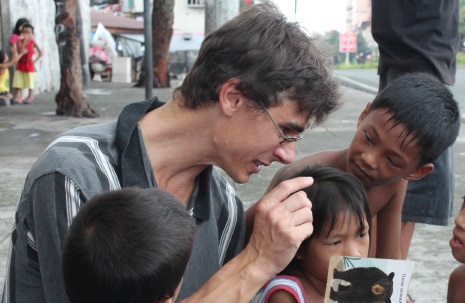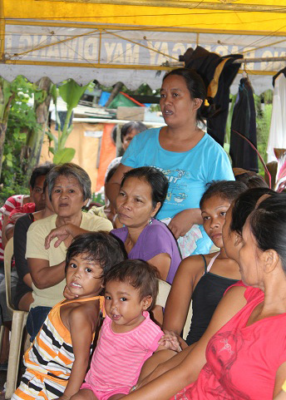Let’s Just Help the Nice Ones

Above: Guy Malfait during his time in the Philippines.
By Guy Malfait – The Philippines
I still remember my mother, returning one day from the bakery, all turned up side down – a poor woman named Andrea (“And even more, a woman of ill repute!” added my mother) had made a scandal after the baker had “given” her a loaf of bread from the day before (which was at any rate unsellable). She had shouted at the baker that, “She should eat her own bread if she thinks it’s so good!”
“It’s really outrageous,” my mother cried. “Those people, they just don’t deserve our help!”
I wasn’t in the bakery that day, and I didn’t know Andrea, but I think I know her through all the people I’ve met over the past few years spent with ATD Fourth World. Take Ate Tela for instance, who lives like hundreds of families, under a bridge, above a sewer, without a roof, in Manila. Once more this year, despite all the interventions of social services, her children continue to miss school to beg for coins at the windows of cars.
These are the poor for whom society didn’t “take”, with whom aid programs don’t “work.” Basically the ones who resist instead of cooperating! “Those people, do they even want to be helped?” we cry eventually in frustration.
To me, it is a fake question because it puts all the problem on the side of those “in need.” It’s a comfortable idea for anyone disposed to “help” – whenever the offer of help isn’t welcomed with gratitude, or is refused, it’s the recipient who is called into question. Only very rarely does the person or the organization behind the offered assistance, let alone society in general, call itself into question.
Let’s get back to Ate Tela in Manila – despite informational meetings and even threats from social services, she keeps sending her children regularly on the streets to beg. How can we understand a mother who voluntarily denies her children schooling? We don’t have an answer. So we invited her children and others from “under the bridge” to the “Street Library.” Via the children, we were able to build a relationship with Ate Tela. It was hard work at the beginning, she was clearly wary of being “preached to” yet again. But then suddenly a change happened. She came more and more often “Just to take a look,” she told us. That simple look became, after a few months, active participation, and then later even taking responsibility in the street library.
It turned out that in fact, Ate Tela was an iconic figure for the families under the bridge. It was to her that they confided their problems, and she would accompany them if necessary to one social service office or the other.
Along with other families, she had participated in a study we conducted seeking to evaluate the Millennium Development Goals. Ate Tela knows better than anyone that school is the key to a better life. But better than anyone too, she knows the reality of most poor children who go to school – they go to school, but they learn next to nothing! It’s logical then that in times of need, children miss school to support their family.
Last June, that conclusions of the study were presented to the United Nations in New York. Ate Tela and the others from under the bridge didn’t become any richer for it! But a fundamental change did come about in them. The sense of being superfluous, of being unheard, was replaced by respect, confidence, self-esteem.
The reaction of Andrea which had so shocked my mother, was it that of a “spoiled child” who refuses bread? Or was it the last piece of self-respect that she wanted to save, telling us that she didn’t want to be satisfied anymore with our “charity?”
That is why I love the Andreas of the world so much – they force me to do a total change of perspective – to turn a problem into an opportunity for humanity!
Originally published at: https://togetherindignity.wordpress.com/2013/11/19/lets-just-help-the-nice-ones/


